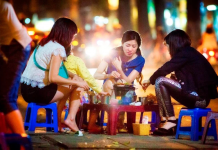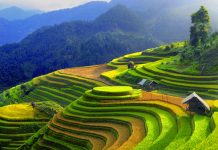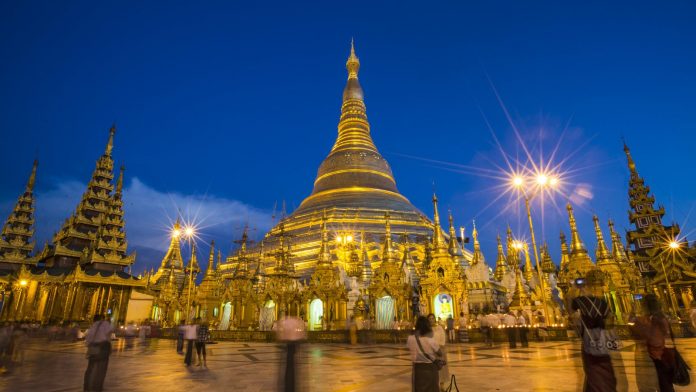Myanmar is such an exciting destination for its distinctive culture and geographical diversity as whole country. So, you can find various kinds of tourism such as adventure, trekking, cultural tour, ecotourism and water-related activities in Myanmar as a one-stop destination. It is a cluster of famous destinations to visit. At the time you are in Myanmar, we would suggest the following top 10 best highlights:
- Bagan
Travelers with a passion for Buddhist temples, pagodas and stupas should have a field day in Bagan, since it contains more of these than any other place in the world. The most popular destination in Myanmar, Bagan was the capital of the First Burmese Empire from the 9th to the 13th centuries. The site that Marco Polo once described as the “gilded city” was home to around Buddhist 13,000 temples in its 11th-century heyday. Where astonishing is a panoramic sight in the sunset too which people from nearby villages and tourists alike approach to revel in, it is indeed unfair to say it has lived long enough only to suffer from the excellence. With over 2,000 pagodas and temples, it remains to tell the story, to the world, it has ever lived
- Golden Rock
Kyaiktiyo Pagoda (also known as Golden Rock) is a well-known Buddhist pilgrimage site in Mon State, Burma. It is a totally awesome sight: a pagoda (zedi) sitting atop a huge boulder that appears as if it’s about to fall off the edge of a cliff. Both are covered in golf leaf. The locals believe the boulder, which sits 1,100 meters (3,600 feet) above sea level, is held in place through a miracle of Buddha; the pagoda is said to contain a strand of his hair. The gravity-defying Golden Rock has always been an important religious shrine amongst the Burmese Buddhist community, but with more and more tourists visiting the country each year the oddly balanced monument has recently become a tourist attraction for the foreigner.
- Ayeyarwady River Cruise
Ayeyarwady also known as the Irawaddy, is Myanmar’s longest river. It begins high in the Himalayas, carving Myanmar in half on its way to the Andaman Sea. It is navigable by large ships and boats in the lower elevations, and is fast becoming a popular river cruise destination. Cruises run between Mandalay and Bagan; both cities offer plenty of temples, pagodas and statues of Buddha. Between the two terminals, cruisers will see river villages and beakless dolphins, and travel through jungles and deep gorges.
- Ngapali beach
Ngapali combines two worlds in this Southeast Asian country. It is Myanmar’s premier resort town, with white sand beaches lining the blue waters of the Bay of Bengal and luxury hotels. It is a great spot to chill out and just relax. Contrast this with its fishing village atmosphere with local restaurants serving the day’s catch and ox-carts doubling as taxis. Locals believe the town is named after Napoli (Naples) in Italy. Most people visit Ngapali November to March; the rest of the year it is a sleepy little beach town.
- Mrauk U
Mrauk U is an important archeological town. It was originally thought to be a fortress because of the thick walls, but the walls were made to protect temples from the fierce winds, not invaders. Stone temples can be found throughout the area. The medieval town was once an important Arakan capital and was an important trading city. Getting to this remote location involves a four- to seven-hour boat ride up a tributary of the Kaladan River. Travelers may want to bring rain gear at the region gets almost 1.2 meter (4 feet) of rain annually.
- Inle Lake
Vast and serene Inle Lake is one of the top tourist attractions in Myanmar. Besides its considerable natural beauty the lake also attracts tourists for the stilt houses of the Intha, the descendants of Mon people from the far southeast. A typical day-trip on the lake, taken in a long, narrow boat with a noisy outboard motor, will stick to the northern reaches of Inle Lake. These trips also include visits to small workshops in stilt villages, several pagodas and probably a market. Travelers are also likely to see fishermen propelling their boats using a distinctive leg-rowing technique, and other Intha residents of the lake tending to fruit and vegetables on floating gardens.
- Shwedagon Pagoda
The Shwedagon or Greater Dragon Pagoda is considered the most sacred site in Buddhism in Myanmar because it contains a strand of Buddha’s hair and other religious relics. The 2,500-year-old pagoda is located on Singuttara Hill in Yangon, the largest city in Myanmar. Over the centuries, the pagoda has grown from 8 meters to 99 meters (26 feet to 366 feet). The origins of Shwedagon are lost in antiquity but it is estimated that the Pagoda was first built by the Mon during the Bagan period, sometime between the 6th and 10th century AD. It is covered in gold leaf; the stupa is covered in 4,531 diamonds. Numerous temples, statues and stupas can be found at this unforgettable site. Pagoda visitors are expected to follow a dress code (trousers preferred, T-shirts with elbow-length sleeves) and enter the temple barefooted.
- Kyaing Tong
Occupying an extensive area in the far east of Shan State in the midst of the infamous Golden Triangle, Keng Tung hosts several opportunities to get intact with the undiscovered yet renowned ethnic minorities. One can go on for a long hike for days to nearby tribal villages including Akha famous for their sartorial practices.
- Ubein Bridge
The world’s longest teak footbridge gently curves 1300yd across shallow Taungthaman Lake, creating one of Myanmar’s most photographed sites. In dry season it feels surreally high and mostly crosses seasonal vegetable gardens. But after the summer rains, the area becomes a big lake and water laps just below the floor planks. Just a few of the 1086 poles on which it stands have been replaced by concrete supports. A great time to visit the bridge is just after sunrise when hundreds of villagers and monks commute back and forth across it. The light is often best around an hour before sunset.
- Loikaw
Travel to this part of Myanmar and you will discover beautiful Kayah hill scenery and a large number of distinctive tribal cultures, the most internationally famous of which are the Kayan, whose ‘long-necked’ womenfolk have a tradition of sporting coils around their necks. Sometimes called Padaung (although this is a Shan word and considered pejorative by the Kayan people), their ‘long-neck’ tradition is in fact gradually dying out; generally, only older women in some rural areas wear the rings (more info further down the page under ‘Tribal villages and Kyet cave’).
There are ten native ethnic groups in Kayah State (also sometimes known as Karenni State), in addition to those from surrounding parts of Myanmar who also live here. The majority of the state’s population is Christian, with animist beliefs entwined in their traditions, whilst the majority of the population in the town of Loikaw is Buddhist.










